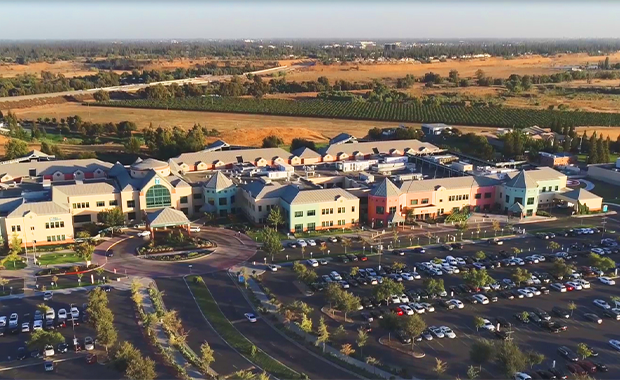Valley Children’s Healthcare To Install Microgrid On California Hospital Campus
This article was originally published on June 16, 2023, and is among Healthcare Design’s most-read articles of 2023. To see a full list, click here.
Located in a rural part of Central California, Valley Children’s Healthcare, which delivers care to more than 1.3 million children, regularly faces the threat of rolling blackouts, unsteady water supplies, and wildfires.
This volatility impacts the organization’s ability to deliver services at its 358-bed standalone Valley Children’s Hospital in Madera, Calif., as well as its specialty and primary care practices.
“Our doors need to stay open because these kids don’t have anywhere else to go,” says Danielle Barry, chief operating officer at Valley Children’s, adding that the hospital has a 45,000-mile catchment area.
(For more on hospital resiliency by way of decarbonization, read “Healthcare Takes Aim at Decarbonization.”
Healthcare building resiliency
About two years ago, the organization began working with Mazzetti (San Francisco) to address its aging infrastructure and improve the resilience of its facilities while also reducing operational costs.
The healthcare organization had already taken some steps on its own, such as procuring the cheapest “dirty electricity” (produced by fossil fuels) possible to keep operating costs down. Additionally, in an effort to address its water needs (wells are used for its water supply), Valley Children’s had been acquiring property near its main campus in Madera to obtain more water rights in the state.
As Mazzetti began studying Valley Children’s assets and facilities as well as future growth plans, it saw an opportunity to utilize that land as a solution to its resiliency needs.
Installing a hospital microgrid
Specifically, the firm decided to install a renewable energy microgrid that comprises solar photovoltaic panels, fuel cells, and battery storage, combined with their existing generators. Valley Children’s was ready to move forward on the project last year, when the Inflation Reduction Act was announced in August 2022, which offers financial savings and tax incentives for energy security and climate change programs.
Additionally, the project team took the opportunity to partner with the California Energy Commission to apply for a grant from the U.S. Department of Energy (DOE) to enhance the microgrid project with new battery technology.
This month, the healthcare network was awarded a $55 million grant from the DOE, provided as part of President Biden’s Investing in America agenda, and will build a renewable energy microgrid.
Valley Children’s solar field, designed in the shape of the hospital’s mascot, George the Giraffe.
This microgrid at Valley Children’s is one of just 15 projects chosen as part of the DOE’s $325 million commitment to fund similar projects nationwide that promote adoption of renewable energy resources and advance critical clean air technologies.
Valley Children’s solar field, designed in the shape of the hospital’s mascot, George the Giraffe, will help provide additional energy storage to improve the hospital’s ability to withstand long duration outages. It will also lessen the load on the utility grid, helping it to better serve the needs of the growing area.
“We want the hospital to be able to operate for a long time with no external power,” Vernon says. “If we win this grant, it will help us do that and show that it’s possible.”
Scheduled to be operational by 2025, the microgrid will be the main power source for the campus, with back-up power available from the local utility and a diesel generator plant.
The microgrid will also get Valley Children’s to its goal of reducing its greenhouse gas emissions by 50 percent by 2030 as part of the White House and Department of Health and Human Services’ Health Sector Climate Pledge.
“It was a cost reduction and resilience project that happened to decarbonize the hospital and improve the health of the community,” Vernon says.
For more on how the healthcare sector is addressing decarbonization, read “Healthcare Industry Takes Aim At Decarbonization.”
Anne DiNardo is executive editor of Healthcare Design. She can be reached at anne.dinardo@emeraldx.com.



